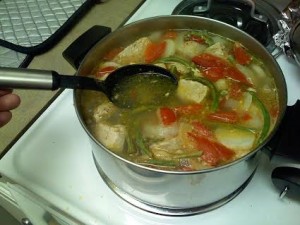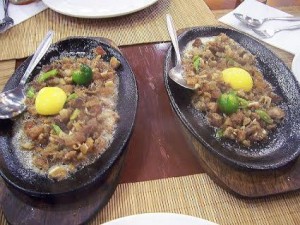Wikipedia photos
Sinigang, adobo, kare-kare, sisig, pork barbeque, lechon, and fried chicken—paired with steaming hot kanin (rice) and equally tasty sawsawan (condiments)—it’s definitely more fun eating in the Philippines!
The Filipino cuisine is unique as it was influenced by both sides of the Pacific — from its neighbors in the region of Malaysia and Indonesia, including China and India, and Mexico—plus the cooking pots of Spain and the United States.
This explains why we have these malinamnam (yummy delicious) cuisine that is loved—not just by our countrymen—but by the visiting tourists from around the world.
1. Rice—A Filipino meal won’t be complete without a steaming hot rice or kanin on the plate. Traditionally, we want our kanin to be wet. In any eatery or restaurant, a meal is served with a soup, whether nilaga or sinigang (for free!)—and the sauce of the ulam (viand) also tops the rice to give it its saucy look and make it muy delicioso.
For fried ulam—the banana ketchup, liver sauce, toyo and fried chicken gravy—make for truly Filipino sawsawan (dipping sauces) and they are almost within arm’s reach to make a meal more appetizing.
2. Sinigang—Filipinos just love sinigang because of its signature maasim (sour) flavor. It is a clear broth soup dish made with a sour fruit (kamias, sampalok, santol, kalamansi, alibangbang, bayabas, batuan, labóg, etc.).
Though this Filipino dish originated from the Tagalog region—there are several other versions to be enjoyed—Pampangos have their bulanglang bayabas (guava), the Visayans have their tinola/tinowa/tuwa, and Bicolanos have cocido (made with tomatoes and a dribble of kalamansi).
Another addition to the sinigang family is the sinigang sa miso (always with fish)—introduced by the Japanese farm workers in Mindanao in the early 1900s.
3. Kare-kare—Do you know that the word karinderia (roadside eatery) was coined by the Indian soldiers during the British Occupation in Manila?
These Indian soldiers, also called Sepoys, chose to settle in Cainta and Taytay in Rizal province. With these towns on the path of pilgrims en route to Antipolo, the settlers opened roadside eateries to feed the pilgrims while they’re along the road, hence, the term karinderia/karihan was coined—referring to a place where one can have kaari (we now know as kare-kare).
According to writer Dr. Ricardo Soler, the term kare-kare came from the Indian dish kaikaari, which the Sepoys introduced, defined as “a sauce, gravy, or stew of vegetables cooked with many spices.”
4. Adobo—This Filipino dish is very popular among Filipinos wherever they may be. The proof—the countless of adobo variants that were produced in every region.
In the Filipino context, adobo generally refers to the meat stew (a.k.a. CPA or Chicken/Pork Adobo) simmered in vinegar, garlic, black peppercorn and bay leaf.
This term also refers to a cooking technique of braising any meat (chicken, pork, beef, quail, duck, venison, seafood, frogs, etc.) or vegetable with the aforementioned ingredients.
5. Bulalo—Being the country’s major cattle producer, Batangas is identified with the popular Filipino dish called Bulalo.
This dish is basically nilagang baka—the boiled beef shank and kneecap (called bulalo in Tagalog) is slow-cooked for a few hours with onions, leeks, salt, and pepper, until much of the collagen and fat has melted into the clear, flavorful broth.
To inject variations—this dish is served with some petsay, cabbage, carrots, potatoes, or corn on the cob.
According to an urban legend, the Bulalo that we know now was popularized by Rose and Grace Restaurant, a Batangas institution since 1970—which served the typical nilagang baka using uniformly cut shanks with bone marrow, served in steaming-hot large bowls.
Interestingly, the same nilagang bulalo is called pochero in Cebu, kansi in Iloilo, and pakdol in Tacloban.
6. Lechon—A fiesta or any special occasion is incomplete without the lechon or whole roasted pig on the feast table.
The traditional manner of roasting lechon continues to be on an open pit—but it’s prepared and served differently.
In the Central Luzon and Southern Tagalog areas, lechon is made with sweet/sour/salty and peppery sauce made with pork liver. The Visayans, meanwhile, stuff the pig with salt, peppercorn, lemongrass, garlic, leeks, and star anise— giving its aromatic taste.
In the Ilocos region, this sumptuous dish is stuffed with karimbuwaya, a cactus plant (Indian spurge tree, Euphorbia neriifolia) with succulent petal leaves that emit a certain citrus aroma and sourness.
7. Sisig—This originally cholesterol-laden dish, served in a sizzling plate is a concoction of pork ears, cheek, and jowl—boiled and grilled over charcoal—until almost charred. Then, it will be mixed with boiled chicken liver, onions, kalamansi, and fresh chili.
Aling Lucing Cunanan of Angeles City, Pampanga gets the credit of inventing the present-day sisig. In the mid-1970’s, she did a makeover on the sisig matua, “grilling further the boiled pig’s head and mixing it with chopped chicken liver.”
Meanwhile, Trellis Restaurant in Quezon City was the first to serve the Pampango delicacy in Metro Manila—which then started the restaurant/grill genre bandwagon.
An added variation to this dish—serving it with a raw egg that will cook on the hot plate—coupled with equally sizzling rice. It can also be mixed with mayonnaise or other preferred condiments.
Healthy versions of this dish have also been created. We now have squid, tuna, shrimp, tofu, or chicken sisig.
9. Pork and chicken barbecue—A children’s party is not complete without this grilled pork or chicken on bamboo sticks, marinated in a proudly Pinoy blend of soy sauce, sugar, banana ketchup and chili.
Barbecue stands in fact can be found in every street corner—where there is smoke—there is this popular barbecue that’s proudly Filipino.
It is also eaten as a pulutan or as an ulam, accompanied with atsara (from the Indian achaar or pickled vegetables and fruits).
10. Fried chicken—“Isa pa, isa pang chicken joy!” (One more, one more chicken joy!) Can you still remember this line from the popular T.V. commercial of Jollibee several years ago?
Indeed, children cannot just get enough of this crunchy and sometimes spicy chicken. And even adults love it! A survey conducted by burger chains revealed that the fried chicken outsells the burger, amounting to more than 60 percent of total sales.
Fried chicken was first introduced by Max’s Fried Chicken in the Philippines in 1945. Soon after, fast food chains KFC and Jollibee introduced the American “southern fried chicken”—coated in flour or batter.
Nowadays, almost all eateries and restaurants in the country have fried chicken on their menu—served with the oh-so delicious gravy!
Among other traditional and appetizing Filipino dishes include lechon kawali/bagnet, crispy pata, kaldereta, bicol express, tapa, tocino, longganisa, kinilaw, lumpia, bistek Tagalog, tinolang manok, chicken inasal, paksiw, daing na bangus, tuyô/danggit/tinapa and pakbet/pinakbet .

